by Briscoe White | Jan 17, 2011 | Containers, Gardening, Growing, Herbs, Indoor Gardening, Miscellaneous, Urban Gardening |
When talking about Rosemary, my mind immediately wanders to the kitchen. That savory piney smell that wafts out from under pot lids, or from a steaming roast or loaf of bread just out of the oven. One of the most basic culinary herbs, Rosemary has remained popular for many reasons since its early use in Greek and Roman cultures where it was used for everything from repelling evil and sickness to symbolizing fidelity between lovers. Though long believed that if grown in kitchen gardens, Rosemary represented the strength of the matriarch of the home, in modern times Rosemary has lost its gender bias and is a culinary herb enjoyed by all. A member of the Mint family, Rosemary is a cousin to Basil, Oregano and Lavender, which explains why they grow and taste so great together! Yet, one of the best reasons to love Rosemary is its ability to grow in many different climates and zones and for its versatile usage and easy care. To give you an idea of what we mean, here’s a crash course in Rosemary!
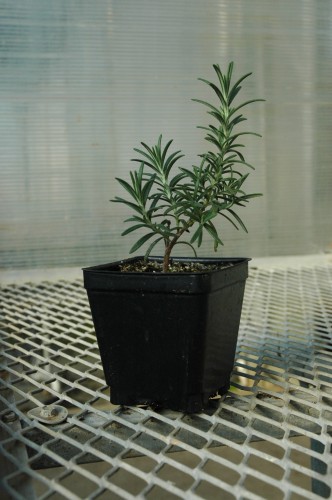
By far the most cold-hardy variety, ‘Arp’ has thin, silvery, needle-like leaves. It’s the plant’s uniquely sized foliage that I believe makes it so temperature-tough, as with less surface area the plant is able to conserve its energy and essentially becomes impenetrable to cold weather. Aromatic and easy to grow, this variety is great because it gives chefs who live in more northern zones, like Zone Six, a delicious culinary option when other herbs can’t survive. Also quite drought resistant, try planting Rosemary ‘Arp’ as a low-growing hedgerow. Brushing past it will release its wonderful scent.
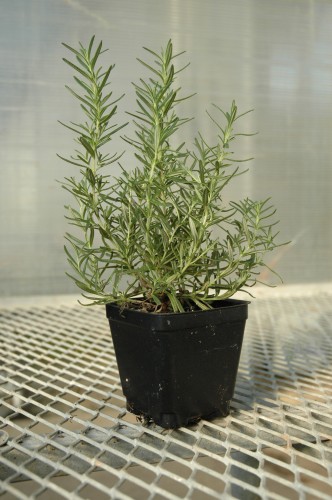
Typical of the traditional Rosemary foliage, ‘Hardy Hill’ is the second most cold tolerant variety and produces characteristic dark green, needle-like foliage. A terrific culinary herb, ‘Hardy Hill’ will survive in cold areas as low as Zone Seven and is drought tolerant. Great on potatoes, in stews and breads, or to season meats, ‘Hardy Hill’ really comes through when the temperatures are low. Similar to Rosemary ‘Arp’, yet possessing a darker color, ‘Hardy Hill’ grows well in containers as well as in your garden, and can be grown indoors during extremely cold temperatures.
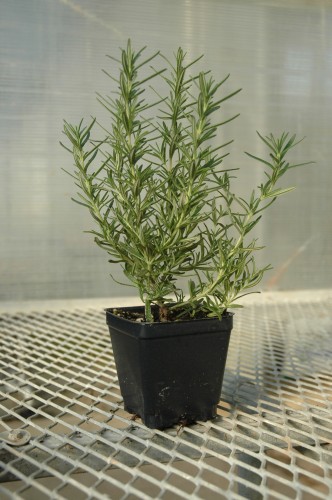
Very similar in habit and look as ‘Hardy Hill’, without the extreme hardiness. ‘Salem’ is a more cold sensitive variety of Rosemary but is more useful in the kitchen. Not only can you use its flavorful foliage to lend a savory distinction to your favorite dish, but you can use its woody branches for barbecue skewers. We actually tried this over the summer when we had lamb kabobs. The natural fragrance and flavor of the Rosemary infused the meat as it cooked over the grill, releasing tons of taste and perfuming the air. Give this a shot the next time you’re grilling pork, lamb or beef. If you don’t feel like making skewers, try sinking the sticks into the full piece of meat to really cook the amazing aroma into your dish. Perennial in Zone Seven through Zone Ten, ‘Salem’ has light, almost smoky green foliage.
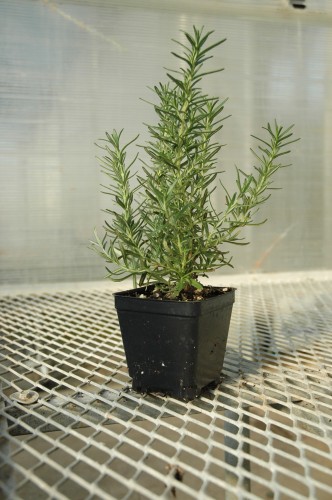
By far the most beautiful of the Rosemary varieties we grow! ‘Tuscan ‘Blue’ produces tons of beautiful blue flowers and lush foliage, making this variety the ideal Rosemary for topiaries. As useful in the kitchen as it is beautiful in the garden, ‘Tuscan Blue’ is used to flavor dishes in many of the same ways as its hardier cousins. Also a terrific indoor herb because of its lovely fragrance and glossy, dark green leaves, ‘Tuscan Blue’ has an erect habit and grows best in Zone Eight through Zone Ten. It’s sometimes best to container plant this delicate beauty for moving indoors, as even cool evening temperatures may upset it.
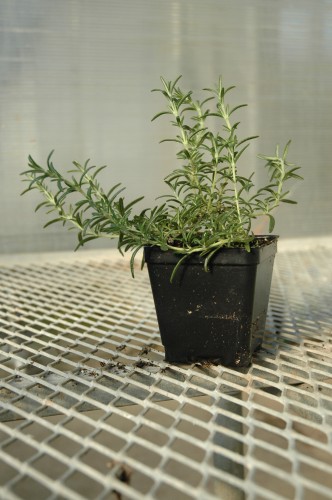
A great ground cover Rosemary, ‘Prostrate’ is not terribly hardy, but where it’s warm enough, this great variety won’t let you down. A landscaper’s dream, ‘Prostrate’ can be planted as a stand alone landscaping shrub, so it doesn’t take up room in your garden. Fashionable and functional, just make sure to plant it in close proximity to your kitchen for easy use. This great dual purpose Rosemary will brighten your yard and your kitchen without using valuable garden space. Try planting this along a garden wall or in a large planter and let it spill over the edge to create a culinary cascade!
Regardless of which Rosemary you prefer, they all have terrific culinary and aromatic value. Planting them in your garden or keeping them indoors will provide you with a delicious herb for your favorite recipes as well as a wonderful fresh fragrance that can’t be matched. Try using your favorite Rosemary variety in wreaths, potpourris, or as centerpieces. By adding Rosemary to a mesh sachet, you can place it in your bath for a soothing soak or in your drawer to freshen up your laundry. You can even extract the oils and use it as an all natural perfume that will actually condition your skin! We love working with this versatile herb in the greenhouse, as we always leave smelling of its sweet, piney scent. The possibilities for using Rosemary are endless! No matter what zone you live in, we have a Rosemary for you, so don’t be discouraged by your location!
by Briscoe White | Jan 13, 2011 | Gardening, Growing, Herbs, Miscellaneous |
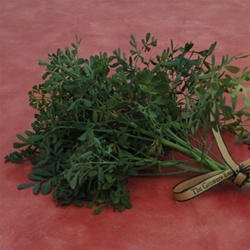
As The Growers Exchange has evolved, herb plants have become our main focus. The wonder of the internet has allowed us to understand what plants people are searching for, so we have tailored our crop to match this demand. Having an “ Herb Plants for Sale” sign on the internet means we get all kinds of requests… Each is a story unto itself so I have to focus on one at a time! This is the story of how we discovered Rue…
Rue is an herb that now has a large presence in our nursery. One day we received a call from a man looking for fresh cut Rue. We sell Rue plants in four inch pots, but we did not have anywhere near enough plants for cutting. After a discussion, he visited the farm while in the area, and we quickly bought a large pack of Rue seed soon after he left. That spring we planted two thousand plants in our orchard, and by late summer we were shipping twenty-five pounds a week to New York City. Our customer is co-owner if the largest botanica on the East Coast. What’s a “botanica” you may ask? We didn’t know either, so I better explain that a botanica caters to people with beliefs that require many natural products not easy to find in a city. People come from near and far to fill their wish list.
Rue is in high demand and we now have thousands of plants in our field, and we ship Cut Rue in lots of one hundred pounds to NYC. I have told the story of how Rue’s phyto-photo toxicity caused second degree burns on several of our workers that mistakenly touched the plant in sunlight, without protective gloves, in our previous blogs. (For a refresher course on how to use Rue, read our latest blogs in Briscoe’s Seeds For Thought.) Jason Mizrahi, co-owner of Original Products buys most of our Cut Rue. I asked him what all the Rue was used for and he explained Rue is used in several ethnic dishes and was used for many medicinal and spiritual purposes. The herb is also thought to bring good luck and prosperity to those that ingest it.
This is good news for us! Though none of us here at The Growers Exchange plan to ever eat or even touch Rue without gloves; we do like growing Rue as a crop. Our Rue field has to be one of the largest anywhere. We find the challenge of growing many different plants fun; we have other unusually large quantities of various other herbs for other special use customers, but none in the quantity we grow Rue. Who knew about Rue?
by Briscoe White | Jan 12, 2011 | Gardening, Growing, Herbs |

Rue is a beautiful, aromatic perennial herb with many culinary and medicinal uses. Hardy from zone 4 to 9, Rue thrives with little care and grows in a shrubby habit. It enjoys hot, dry climates, and poor, sandy, even rocky soil, and proves to be pretty drought-resistant when established. Great in rock gardens and areas where little else will sprout, this beautiful and practical herb has a rich history and is a cinch to grow!
Rue can be started from seeds and usually germinates in one to four weeks. Rue seeds need light to germinate; be sure to surface-sow your seeds before setting them in a warm, sunny area. Seeds can typically be sown at sixty-eight degrees Fahrenheit for topical germination. Check out our seedlings and young rue plants below! (more…)
by Briscoe White | Jan 10, 2011 | Gardening, Herbs |

Though Rue’s rich history is merely a memory to many these days, this hardy perennial herb still has a lot to offer. From the mystical to the mundane, Rue has been a popular herb throughout time with many modern applications that are often overlooked. A flavorful herb to season your favorite dish when used sparingly, an attractive organic insect and pest repellent, and a powerful natural antispasmodic, Rue is a terrific aromatic herb for any garden.
Also commonly known as ” the Herb of Grace” or the “herbe a’la belle fille” (the Herb of Fair Maidens) in France, Rue has long been a symbol of virtue and purity. As part of traditional Lithuanian wedding rites, the bride wears a crown of Rue which is burned during the ceremony to symbolize her transition from the whimsy and virtue of childhood to the responsibilities of motherhood and adulthood. A sprig of Rue is also presented to the marrying couple to lend clarity to their marriage. In many parts of the world, Rue was also used to repel witches and evil spirits because of its strong, pungent odor and effect on the body. Sprigs of Rue were ingested to guard against spells, and was considered a very reliable “anti magic” defense. This belief started with Ancient Greeks who, when dining in the company of strangers, ate Rue to calm their indigestion, which they attributed to their new guests using witchcraft to cast spells upon them. Ironically, Rue was also used in witchcraft to create and cast spells. Because of the herb’s astringent and abortive properties Rue was used to poison, blister, and in some cases, make the victim of the spell miscarry. Rue was also used to give a person “second sight” and was believed to help see into the future. This old-world reverence of Rue as a sacred herb and guard against evil also manifests itself in the Catholic Church, where it is dipped in Holy Water during High Mass and then sprinkled over parishioners to bless them.
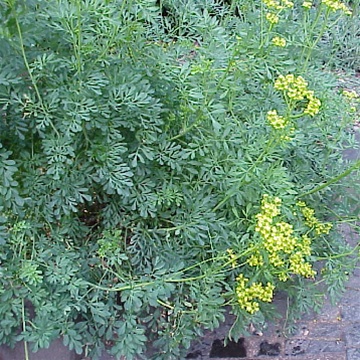
Also heavily used in art and literature, Rue is closely related to regret or remorse and even the word “rue” in its literal sense means to repent or lament. Mentioned by Milton, Shakespeare and in the Bible, in the Book of Luke, Rue is used as a constant symbol of guilt, sorrow and anguish. It was common to eat Rue among Italian artists, including Michelangelo and da Vinci, to sharpen their creativity and eye sight during tedious periods of painting or sculpting. The strong, bitter taste of the Rue was thought to awaken the senses and encourage productivity. This thought that Rue could aid eyesight was also shared by expert marksmen who coated their gun flints and bullets with a mixture that included Rue to make their aim more true.
Rue has lost its popularity as a modern medicinal herb because of its bitter taste, its ability to nauseate and poison if taken in too large a dose, and the difficulty to harvest it due to allergic reactions with the plant’s oil when combined with UV light. This phenomenon is called Phytophotodermatitis and can be contracted when your skin comes into contact with the Rue plant in direct light. The plant’s oils are activated by the light and can cause very painful blistering, rashes and skin irritation, similar to poison ivy. Characteristic of all members of the Citrus family, Rue shares this quality with Lemons, Oranges and Limes. The best way to avoid this painful reaction is to wear long sleeves and gloves when tending Rue and to harvest it early or late in the day when the sun’s rays are weaker. Washing affected areas quickly can help alleviate the reaction, as well as applying Aloe, Calendula or over the counter antihistamines directly to the points of contact. Rue was traditionally used for its powerful emmenagogic properties (an agent that encourages menstrual flow), by women suffering from various menstrual problems, but is no longer deemed a safe alternative to other herbal antispasmodics because of the high chance of miscarriage. This being said, Rue should never be handled or ingested by pregnant women.
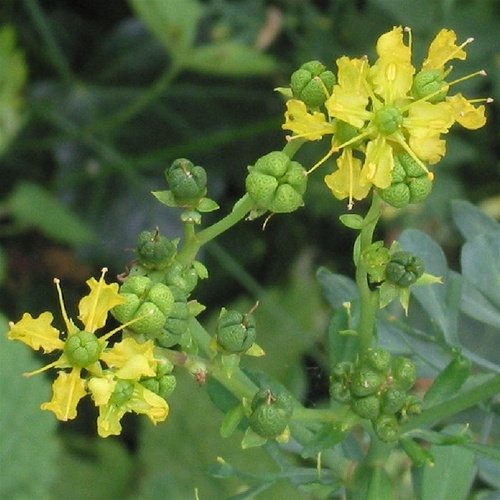
Rue’s most present-day use is in the kitchen as a culinary herb, and it is the staple of many cultural foods throughout the Mediterranean, Greece, Italy and Ethiopia. Used in small quantities, as it packs a potent punch and tends to overwhelm a dish easily, Rue is a strong, savory herb. When dried, the herb takes on a more bitter taste which comes from the presence of Rutin, a chemical also found in Watercress, Capers and Orange Peel. In Ethiopia, the leaves and berries of the Rue plant are used to create a traditional spice mix called Berbere and it is used in many Mediterranean recipes to lend a strong flavor to fish, cheese and meats. Because its taste is complimented by other savory herbs, Rue is a great addition to Italian recipes like tomato sauces that require Capers, Marjoram, Basil and Lovage. To lessen the bitterness of this multipurpose herb, extract just the oil from the Rue leaves by adding it in for a few minutes at the end of the cooking time, once your sauce or soup has reached a slight boil. Take the leaves out after a minute and discard, like when cooking with Bay leaves. This will maximize the flavor of the Rue while leaving the bitterness to a minimum.
Although we think of Rue as an outdated, old fashioned and even ancient herb, there are lots of reasons to still grow this wonderfully ornamental plant in your garden. Aside from its many practical and cultural applications, it’s a beautiful, yellow flowering perennial with broad, blue-green foliage. It acts as a natural insect, deer, cat and dog repellent and has a strong, citronella-like fragrance. Rue leaves were the basis for the club design on playing cards and will lend a lovely contrast to your gardenscape. A hardy herb, Rue will grow easily in well-drained soil and its verdant leaves will add lovely cover for surrounding plants. As Rue is making a graceful comeback, try planting it as a useful ornamental or buying it in bulk as a cut herb for culinary and spiritual purposes–the possibilities for this versatile herb are endless!
by Briscoe White | Dec 29, 2010 | Gardening, Inspiration, Life on the Farm |

Well, though it’s too cold to ship most plants for us here at The Growers Exchange, we’re still hard at work sowing and growing for the spring season. Neither wind nor rain nor sleet nor snow have kept us away (someone has to be here to stoke the wood stove that heats the greenhouse!), but it sure makes it worth while to see such wintry natural beauty! When we braved the roads to get to the office after a recent heavy snowstorm, we were greeted with a row of glistening icicles hanging like a frozen curtain from our porch roof.
The recent frigid temperatures have made it hard on any plants left out to fend for themselves, so how can you protect them when the forecast is calling for snow? Cold frames, hoop tunnels and extra mulching are great ways to protect your plants during the cold months. We use cold frames and tunnels to keep the frost from killing herbs like Rue, which we grow in one of our fields for medicinal, culinary and cultural usage. Many supplies needed to build these season-extending protectors, like old lumber or discarded window frames with the panes still intact, can be found laying around your garage or barn. Otherwise the necessary resources can be bought fairly inexpensively at your local hardware store.
Other easy cold thwarting tricks are to plant large, shrubby evergreens or a tough perennial like Rosemary ‘Hardy Hill’, around your garden to protect smaller, more vulnerable plants from icy winds. Positioning your gardens along a south facing wall of your home will also ensure that it gets lots of warmth from the sun as well as heat escaping from your home. For more information on building cold frames or hoop tunnels, check out some of the educational videos listed on YouTube.com, like this one that we found from gardenfork.tv:
How to Build a Cold Frame
by Briscoe White | Dec 22, 2010 | Basics, Containers, Flowers, Gardening, Herbs, Indoor Gardening, Miscellaneous |
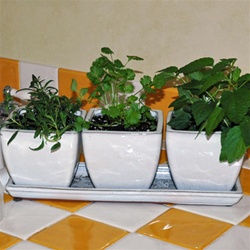
With winter here and in full force already (whether we like it or not), I’ve had to bring in a number of our outdoor plants. My first concern was to find space for all of the various sized pots and to make sure no one was going to trip over them. Once I had my living clutter settled in for the season, I began thinking about how to keep them healthy and happy throughout these long cold months, especially when we have everything from cacti to hardy herbs like Rosemary. Depending on what type of plants have moved into your home for the holidays, here are some general rules of thumb and just plain good advice for keeping them alive and well.
Lighting
We don’t think much about the amount of light outside as it changes from season to season, when we’re indoors and warm with electric lights, but this is a major factor for your plants. Especially with this time of year being the shortest amount of daylight we’ll see, you need to make sure your plants are getting the amount they need. Though probably dormant for the season, your flowering plants tend to like more light than evergreens, cacti and other foliage hardy plants. Whether you unsash your curtains, open the blinds or add additional artificial light, your plants will need a little UV boost through the winter. Even getting your hands on the best led grow lights will offer your plants with the right amount of sunlight that can help them to flourish in their surroundings. Make sure to turn them occasionally to allow all sides and leaves to get plenty of light. This will also help them from growing at a crooked angle, as most tend to grow towards a light source.
Water
If you’re feeling dried out from running your heat on high, chances are that your plants may be, too. Make sure to water them appropriately. Excluding cacti and other succulents, an easy way to tell if your plant needs water is to stick your finger partially into the dirt to test it. If it’s bone dry, don’t drown it. Water moderately and monitor its progress. If you find that your plants are needing water at alarming rates, check to see where you have them placed. On top of a radiator or next to your fireplace may be too hot for their liking.
Temperature
So, you’ve moved your little green friends indoors and you figure that should keep them safe from the temperatures, right? Think again. Some plants can be highly sensitive to heat and cold so make sure you aren’t placing your Basil plant near a cold, drafty vent or your Lemongrass right beside your wood furnace. Depending on their particular needs, temperature can even speed and slow the growth process for your plants, just like an artificial changing of the seasons. For example, with Amaryllises, because they are flowering bulbs, temperature plays a huge part in their growth cycle. We brought some in from the greenhouse for the holidays and the ones placed near our radiator bloomed in a week! I guess we tricked them into thinking it was Spring!
Cleaning and Prevention
Another great thing about having your plants close at hand when it’s too cold to go outside, is that you can’t help but to notice them. The winter months are a great time to get to know your plants’ personalities and to give them a good cleaning. Dust and microscopic debris build up on the plant’s leaves which can block sunlight and the plant’s pores. Try cleaning the tops and bottoms of your plant’s leaves with a damp cloth to remove any unwanted buildup that may be hindering your plant from being its healthiest. While you’re at it, take a close look for insects and disease. For a longer lasting plant, it’s best to nip an infestation or blight in the bud. In most cases, warm water and a mild soap will do the trick to remove many common pests. For a deeper rooted problem, try an all natural pesticide or fungicide, which can be bought at your local hardware store.
Positioning
Plants prefer a routine and moving them into your home can be quite an adjustment. To alleviate further disruption to their transition indoors, try to find permanent spots for them when you bring them in. If you can place them in areas where they won’t be disturbed by the hustle and bustle of the holidays, pets, kids or just because they’re in the way, they’ll greatly appreciate it. Moving potted plants too often can really disrupt and unsettle their soil and root structure. Leaving them to settle in and stay sedentary will cause the least amount of stress on them, as leaves, stems, flowers and branches can break, become weak or tear during the moving process. This will also allow the roots to stay strongly grounded, as soil won’t be jostled about, loosening the plant’s hold.
Potting
Making sure your plants are in the best pot or container is also crucial to its health. Think about it. When you start to outgrow your shoes, the constriction and tightness is uncomfortable, right? Well, many plants need to be moved to larger containers as they get bigger to give them more adequate space to stretch and grow bigger. The winter is a great time for this as the cool temperatures make the process less stressful on your plants. Give your plants plenty of room to grow and you’ll get to enjoy larger and longer lasting results.
Once the stress of the holidays has wound down, indoor gardening can be a terrific therapeutic hobby…or, during the holidays if you need an escape from the madness! Gardening, in general, can actually make for a very fulfilling past time as it can keep you productive, environmentally-minded, creative and, by growing your own produce, can actually save you money. For other hobby ideas, be sure to visit this website – https://tlhobbyideas.com. Gardening year round allows you to enjoy the fruits of your hard work constantly and the calming presence of your indoor plants will bring beauty and fresh aroma to these bleak winter days. Many plants can be easily started indoors during the colder months, for transplant in the spring to an outdoor garden. Try growing your favorite culinary herbs indoors this season to spice things up in your stews and other hearty recipes or just to lend a savory fragrance to your home. By growing now, you will be more prepared once spring gets here!












